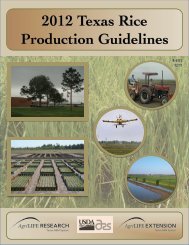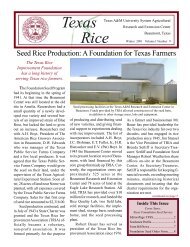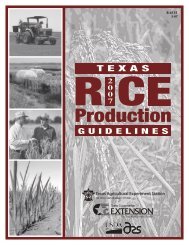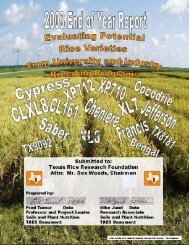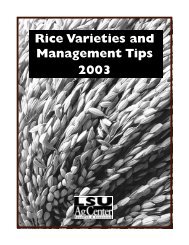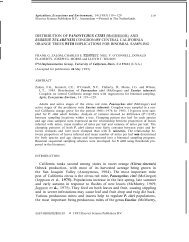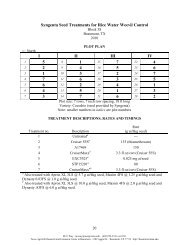Texas Rice - Texas A&M AgriLIFE Research Center at Beaumont ...
Texas Rice - Texas A&M AgriLIFE Research Center at Beaumont ...
Texas Rice - Texas A&M AgriLIFE Research Center at Beaumont ...
Create successful ePaper yourself
Turn your PDF publications into a flip-book with our unique Google optimized e-Paper software.
Conserv<strong>at</strong>ion Tillage continued...<br />
costs. Th<strong>at</strong>’s a $2,560 savings on a 500-acre farm.<br />
Fuel savings - Save an average 3.5 gallons an acre<br />
compared to conventional tillage systems.<br />
Improved long-term productivity - The less you till,<br />
the more carbon you keep in the soil to build organic<br />
m<strong>at</strong>ter and promote future productivity. Intensive tillage<br />
speeds the breakdown of crop residues and the<br />
loss of organic m<strong>at</strong>ter.<br />
Higher soil moisture - Crop residues reduce w<strong>at</strong>er<br />
evapor<strong>at</strong>ion from the top few inches of the soil. Notill<br />
can make as much as two additional inches of w<strong>at</strong>er<br />
available for growing plants in l<strong>at</strong>e summer.<br />
Improved w<strong>at</strong>er infiltr<strong>at</strong>ion - Crop residues act as<br />
tiny dams to slow w<strong>at</strong>er runoff from the field, allowing<br />
the w<strong>at</strong>er more time to soak into the soil. Infiltr<strong>at</strong>ion<br />
is also increased by channels (macropores) cre<strong>at</strong>ed<br />
by earthworms and old plant roots th<strong>at</strong> are left intact.<br />
All help significantly to reduce or elimin<strong>at</strong>e field runoff.<br />
Decreased soil compaction - Reduced weight and<br />
horsepower requirements with no-till can help minimize<br />
compaction. Additional field traffic required by<br />
intensive tillage breaks down the soil structure, promoting<br />
compaction.<br />
Improved soil tilth - No-till increases soil particle<br />
aggreg<strong>at</strong>ion (small soil clumps) which makes it easier<br />
for w<strong>at</strong>er to move through the soil and allows plants<br />
to use less energy to establish roots.<br />
More wildlife - Crop residues provide shelter and food<br />
for wildlife, such as game birds and small animals.<br />
Improved surface w<strong>at</strong>er quality - Crop residues help<br />
hold soil particles and associ<strong>at</strong>ed nutrients and pesticides<br />
on the field. On some sites, conserv<strong>at</strong>ion tillage<br />
can cut runoff r<strong>at</strong>es in half, thus protecting lake, river,<br />
and stream w<strong>at</strong>er quality.<br />
Reduced soil erosion - Crop residues on the soil surface<br />
reduce erosion by w<strong>at</strong>er and wind. Depending on<br />
the amount of residues present, soil erosion can be reduced<br />
by up to 90% compared to an unprotected, intensively<br />
tilled field.<br />
Reduced release of carbon gases - Less tillage keeps<br />
n<strong>at</strong>urally occurring carbon in the soil for use as organic<br />
m<strong>at</strong>ter. Intensive tillage releases soil carbon into<br />
the <strong>at</strong>mosphere as carbon dioxide where it can combine<br />
with other gases to contribute to global warming.<br />
Reduced air pollution - Crop residues reduce wind<br />
erosion and the amount of dust in the air. Lower horse-<br />
4<br />
Managing crop residue<br />
Ideally, crop residue management begins <strong>at</strong> harvest<br />
with proper distribution of residue behind the combine.<br />
It continues with subsequent residue cover<br />
measurements after each trip (fall or spring tillage oper<strong>at</strong>ions)<br />
and finishes with measurements after planting<br />
to ensure th<strong>at</strong> desired levels are achieved.<br />
Between harvesting and planting oper<strong>at</strong>ions, a large<br />
portion of residue cover may be lost from overwintering<br />
or from burial by tillage equipment for those not<br />
using no-till systems. Because overwintering losses<br />
are nearly impossible to control, crop residue management<br />
str<strong>at</strong>egies typically concentr<strong>at</strong>e on limiting<br />
tillage practices to maintain high levels of surface<br />
cover.<br />
The amount of crop residue cover th<strong>at</strong> remains behind<br />
a combine depends primarily on type of crop and<br />
crop yield. Row spacing can also influence cover but<br />
to a lesser degree than the crop grown. In nearly all<br />
crop production systems, residue cover following harvest<br />
is 70% or higher. Exceptions are crops where large<br />
quantities of biomass are removed (corn silage), low<br />
residue-producing crops (soybeans), or below-normal<br />
crop yields.<br />
Typically, there is little or no difference in residue<br />
cover remaining after harvest among varieties of a<br />
given crop when yields are normal or above-normal.<br />
Combine Adjustments and Accessories<br />
Wider combine headers and higher residue production<br />
with new crop varieties are two reasons a well<br />
adjusted combine is critical to high-residue farming.<br />
Without special <strong>at</strong>tachments or modific<strong>at</strong>ions, combine<br />
headers of 20-30 feet or more are not adequ<strong>at</strong>ely<br />
equipped to spread today’s larger volumes of residues<br />
uniformly.<br />
Common Problems<br />
The most common mistake made in the harvesting<br />
oper<strong>at</strong>ion is to allow crop residue to accumul<strong>at</strong>e in<br />
windrows behind the combine. This accumul<strong>at</strong>ion<br />
causes the soil under the windrows to stay wetter and<br />
cooler which can limit early season plant growth. Planting<br />
into windrows can result in uneven stands because<br />
the seeds take longer to germin<strong>at</strong>e and grow, resulting<br />
in significant yield reductions.<br />
Other problems associ<strong>at</strong>ed with improper combine<br />
residue distribution include uns<strong>at</strong>isfactory weed con-



